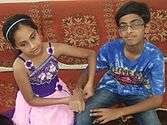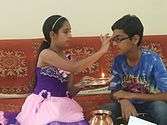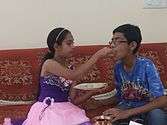Raksha Bandhan
| Raksha Bandhan | |
|---|---|
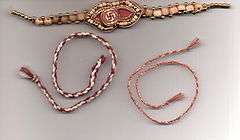 Examples of rakhi | |
| Official name | Raksha Bandhan. |
| Also called | Rakhi, Rakhri |
| Observed by | Religious festival: Hindus |
| Type | Indian and Nepali |
| Celebrations |
Religious: sister and brother get together, tie rakhi on wrist, perform aarti,[1] mark tilak, brother promises to protect sister, sister feeds brother, brother gives gift, hugs Multicultural: tying rakhi, giving gifts, honoring relationships of siblings |
| Date | Purnima (full moon) of Shrawan |
| 2015 date | Saturday, 29 August; 12 Shrawan 2072 B.S as of Hindu lunar Nepali calendar |
| 2016 date | Thursday, 18 August; 2 Bhadra 2073 B.S as of Hindu lunar Nepali calendar |
| 2017 date | Monday, 7 August |
| 2018 date | Sunday, 26 August |
| Related to | Bhai Duj; Bhai Tika |
Raksha Bandhan (Nepali: रक्ष्या बन्धन ; Marathi: रक्षा बंधन ; Hindi: रक्षा बन्धन), also called as Raksha Bandhana (Kannada: ರಕ್ಷಾ ಬಂಧನ), Rakhi Purnima , (Punjabi: ਰੱਖੜੀ) Rakhri or simply Rakhi in many parts of India and Nepal, is a Hindu religious and secular festival.[2] In simple words, Raksha bandhan means "bond of protection". [3]
The festival celebrates the love and duty between brothers and sisters. It is also popularly used to celebrate any brother-sister type of relationship between men and women who may or may not be biologically related. The festival is also observed by Jains as a religious festival,[4] as on Raksha Bandhan, Jain priests give threads to devotees.[5] The Brahmins and Bahuns (Vedic Brahmins) of Nepal and North India change their Janai on this occasion.[6][7]
The festival is also celebrated by many communities as a secular festival.[8] This secular aspect is observed among all people, irrespective of their religion, in West Bengal and Punjab.[9] Various fairs are held in Punjab to mark the occasion.[10]
On Raksha Bandhan, a sister will tie a rakhi (sacred thread) on her brother's wrist. This symbolizes the sister's love and prayers for her brother's well-being, and the brother's lifelong vow to protect her.[11][12] The festival falls on the full moon day (Shravan Poornima) of the Shravan month of the Hindu lunisolar Nepali calendar.[13] Raksha Bandhan is primarily observed in northern and western India, Mauritius and major parts of Nepal. It is also celebrated by Hindus in parts of Pakistan,[14] and by some non-resident Indians and non-resident Nepalis around the world.[15]
Religious festival
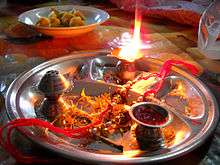
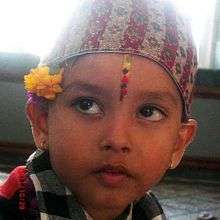
Raksha Bandhan as a religious festival focuses on performing the aarti and saying prayers prior to tying the rakhi. The prayers draw inspiration from the Hindu scriptures. The other religious feature is the application of the tilak on the forehead of the person wearing the rakhi.
Significance
Raksha Bandhan in Sanskrit literally means "the tie or knot of protection".[16] The word Raksha means protection, while Bandhan is the verb to tie. It is an ancient Hindu festival that ritually celebrates the love and duty between brothers and their sisters.[7][17] The sister performs a rakhi ceremony, then prays to express her love and her wish for the well being of her brother; in return, the brother ritually pledges to protect and take care of his sister under all circumstances. It is one of the several occasions in which family ties are affirmed in India.[6]
The festival is also an occasion to celebrate brother-sister like family ties between cousins or distant family members,[18] sometimes between biologically unrelated men and women.[19] To many, the festival transcends biological family, brings together men and women across religions, diverse ethnic groups and ritually emphasizes harmony and love. It is observed in the Hindu calendar month of Śrāvaṇa, and typically falls in August every year.[6][7][20]
Description and rituals
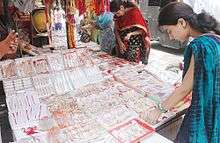
The festival is marked by the several rituals, which vary regionally within India. Typical rituals include: Prepare for Raksha Bandhan Days or weeks before Raksha Bandhan, women shop for rakhi, the ceremonial thread to tie around her brother's (or brother-like friend's) wrist. Some women make their own rakhi.[21] A rakhi may be a simple thread, woven and colorful, or may be intricate with amulets and decorations. Sometimes, a rakhi may be a fancy watch or men's wrist accessory in the form of bracelet or jewelry. Rakhi in the form of a colorful woven thread is most common. Typically the brother also shops for gifts for his sister, ahead of Raksha Bandhan. The gift from the brother can be a simple thoughtful token of love, and may be more elaborate.[6][22]
Rakhi ritual On the morning of Raksha Bandhan the brothers and sisters get together, often in nice dress in the presence of surviving parents, grandparents and other family members. If the sister and brother are geographically separated, the sister may mail the rakhi ahead of the Raksha Bandhan day, along with a greeting card or letter wishing her brother well. The ritual typically begins in front of a lighted lamp (diya) or candle, which signifies fire deity. The sister and brother face each other. The sister ties the rakhi on her brother's wrist.[6]
Prayer, aarti, promise and food
The key rituals of Raksha Bandhan. In the first image, the rakhi is evident on the brother's wrist. | |||||
Once the rakhi has been tied, the sister says a prayer for the well being of her brother – good health, prosperity and happiness. This ritual sometimes involves an aarti, where a tray with lighted lamp or candle is ritually rotated around the brother's face, along with the prayer and well wishes.
The prayer is a self composed note, or one of many published Rakhi poems and prose.[23] One of the earliest examples of a Rakhi prayer is found in Book V, Chapter V of Vishnu Purana; it is the prayer that Yasoda says while tying a Raksha Bandhan amulet on Krishna's wrist.[24][25] An abridged form of the prayer is:
May the lord of all beings protect you,
May the one who creates, preserves and dissolves life protect thee,
May Govinda guard thy head; Kesava, thy neck; Vishnu, thy belly;
the eternal Narayana, thy face, thine arms, thy mind, and faculties of sense;
May all negativity and fears, spirits malignant and unfriendly, flee thee;
May Rishikesa keep you safe in the sky; and Mahidhara, upon earth.
After the prayer, the sister applies a tilak (tikka), a colorful mark on the forehead of the brother. After the tilak, the brother pledges to protect her and take care of his sister under all circumstances.[6][16]
The sister then feeds the brother, with her hands, one or more bites of sweets (desserts), dry fruits and other seasonal delicacies.[16][26]
- Gifts and hugs
The brother gives his sister(s) gifts such as cards, clothes, money or something thoughtful. The brother may also feed his sister, with his hands, one or more bites of sweets, dry fruits and other seasonal delicacies. They hug, and the larger family ritually congratulate the festive celebration of brother-sister love and protection.[6][22]
The brothers wear the rakhi for the entire day, at school or work, as a reminder of their sisters and to mark the festival of Raksha Bandhan.[27]
Myths and parables
The scriptures, epics of Hinduism is peppered with stories of rakhi and Raksha Bandhan. Some of these include:
Indra Dev
According to Hindu scripture Bhavishya Purana, in the war between Gods and demons, Indra – the deity of sky, rains and thunderbolts – was disgraced by the powerful demon King Bali. Indra’s wife Sachi consulted Vishnu, who gave her a bracelet made of cotton thread, calling it holy.[13] Sachi tied the holy thread around Indra wrist, blessed with her prayers for his well being and success. Indra successfully defeated the evil and recovered Amaravati. This story inspired the protective power of holy thread.[16][22][28] The story also suggests that the Raksha Bandhan thread in ancient India were amulets, used by women as prayers and to guard men going to war, and that these threads were not limited to sister-brother like relationships.[13] Some parents allow their kids to do one or two of those steps.
King Bali and Goddess Laxmi
According to this legend, credited to Hindu scriptures Bhagavata Purana and Vishnu Purana, after Vishnu won the three worlds from the demon King Bali, he was asked by Bali that Vishnu live in his palace, a request Vishnu granted. Vishnu's wife, Goddess Lakshmi did not like the palace or his new found friendship with Bali, and preferred that her husband and she return to Vaikuntha. So she went to Bali, tied a rakhi and made him a brother to her. Bali asked her what gift she desired. Lakshmi asked that Vishnu be freed from the request that he live in Bali's palace. Bali consented, as well accepted her as his sister.[29]
Santoshi Maa
Ganesh had two sons, Shubh and Labh. On Raksha Bandhan, Ganesh's sister visited and tied a rakhi on Ganesh's wrist. The two boys become frustrated that they have no sister to celebrate Raksha Bandhan with. They ask their father Ganesh for a sister, but to no avail. Finally, saint Narada appears who persuades Ganesh that a daughter will enrich him as well as his sons. Ganesh agreed, and created a daughter named Santoshi Maa by divine flames that emerged from Ganesh's wives, Ruddhi (Amazing) and Siddhi (Perfection). Thereafter, Shubh Labh (literally "Holy Profit") had a sister named Santoshi Maa (literally "Goddess of Satisfaction"), who loved and protected each other.[30]
Krishna and Draupadi
Krishna considered Draupadi his friend. When Krishna cut his finger while beheading Shishupal, Draupadi immediately tore off a piece of her sari and bandaged his cut. Krishna said that with this loving act, she wrapped him in debt and he would repay each “thread” when the time arrives. Indeed, whenever Draupadi needed Krishna’s protection she fervently prayed for his help, he came to the rescue and gave her unlimited cloth. This is one of the stories of the origin of the Raksha Bandhan festival.
In the epic Mahabharat, Draupadi tied a rakhi on Krishna, while Kunti tied her rakhi on her grandson Abhimanyu, before the great war.[28]
Yama and the Yamuna
According to another legend, Yama, the god of Death, had not visited his sister Yamuna for 12 years. Yamuna, the goddess of Yamuna river, was sad and consulted Ganga, the goddess of Ganga river. Ganga reminded Yama of his sister, upon which Yama visits her. Yamuna was overjoyed to see her brother, and prepared a bounty of food for Yama. The god Yama was delighted, and asked Yamuna what she wanted for a gift. She wished that he, her brother should return and see her again soon. Yama was moved by his sister's love, agreed and to be able to see her again, made river Yamuna immortal. This legend is the basis for a Raksha Bandhan-like festival called Bhai Duj in some parts of India, which also celebrates brother-sister love, but near Diwali.[31][32]
Rakhi and its colour significance
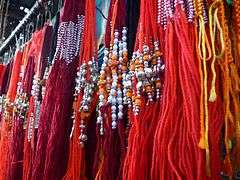
Each colour has a significance in this festival. Tagore used white, so white signifies friendship. Indrani used red for her husband Indra, so red signifies Love and loyalty. The last Orange and Yellow is most popular in India used by Laxmi and Yamuna for their brothers Bali and Yama so this colour is used for brothers.
Multicultural festival
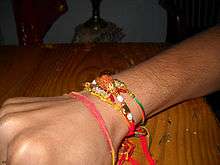
Celebration
Raksha Bandhan is viewed as a non-denominational,[33] multicultural event.[34] Priests tie rakhis around the wrists of congregation members. Rakhis are often shared between close friends. Women tie rakhis around the wrists of the heads of state, political party or social leaders. Ceremonies are also held to tie Rakhi around the wrists of soldiers.[35]
The festival honors relationships of siblings and is akin to siblings day observed in the United States. The festival centres on the mutual bond of protection whereby siblings pray for each other's wellbeing.[36]
Accordingly, some Muslims in India view it a secular, multicultural festival,[37] including the Ismaili community,[38] and was observed in Mughal palaces.[39] Raksha bandhan has been adopted by the Christian community who view it as a festival of historical and social importance,[40] and is also traditionally observed as a secular festival by Sikhs,[41][42][43] which involves the tying of the rakhi and giving of gifts.[44] The secular aspect of the festival concentrates on the female tying a rakhi on a male who in turn gives a gift.[45] The religious features of aarti and applying the tilak are not observed.
Historical references
The multicultural aspects of Raksha Bandhan can be gleaned from history dating back thousands of years. It has many myths and historic legends linked to it. For example, the Rajput queens practised the custom of sending rakhi threads to neighbouring rulers as a token of brotherhood.[37][46]
Alexander the Great and King Puru
According to one legendary narrative, when Alexander the Great invaded India in 326 BCE, Roxana (or Roshanak, his wife) sent a sacred thread to Porus, asking him not to harm her husband in battle. In accordance with tradition, Porus, the king of Kaikeya kingdom, gave full respect to the rakhi. In the Battle of the Hydaspes, when Porus saw the rakhi on his own wrist and restrained himself from attacking Alexander personally.[47]
Rani Karnavati and Emperor Humayun
Another controversial historical account is that of Rani Karnavati of Chittor and Mughal Emperor Humayun, which dates to 1535 CE. When Rani Karnavati, the widowed queen of the king of Chittor, realised that she could not defend against the invasion by the Sultan of Gujarat, Bahadur Shah, she sent a rakhi to Emperor Humayun. Touched, the Emperor immediately set off with his troops to defend Chittor.[48] Humayun arrived too late, and Bahadur Shah managed to sack the Rani's fortress. Although contemporary commentators and memoirs do not mention the rakhi episode and some historians have expressed skepticism about it, it is mentioned in one mid-seventeenth century Rajasthani account.[49]
Rabindranath Tagore and rakhi
Rabindranath Tagore, the Indian Nobel Laureate for literature, invoked Raksha Bandhan and rakhi as concepts to inspire love, respect and a vow of mutual protection between Hindus and Muslims during India's colonial era.[50] In 1905, the British empire divided Bengal, a province of British India on the basis of religion. Rabindra Nath Tagore arranged a ceremony to celebrate Raksha Bandhan to strengthen the bond of love and togetherness between Hindus and Muslims of Bengal, and urge them to together protest the British empire. He used the idea of Raksha Bandhan to spread the feeling of brotherhood. In 1911, British colonial empire reversed the partition and unified Bengal, a unification that was opposed by Muslims of Bengal. Ultimately, Tagore's Raksha Bandhan-based appeals were unsuccessful. Bengal not only was split during the colonial era, one part became modern Bangladesh and predominantly Muslim country, the other a largely Hindu Indian state of West Bengal. Rabindranath Tagore started Rakhi Mahotsavas as a symbol of Bengal unity, and as a larger community festival of harmony.[51] In parts of West Bengal, his tradition continues as people tie rakhis to their neighbors and close friends.[52]
One of Tagore's poem invoking rakhi is:[53]
The love in my body and heart
For the earth's shadow and light
Has stayed over years.
With its cares and its hope it has thrown
A language of its own
Into blue skies.
It lives in my joys and glooms
In the spring night's buds and blooms
Like a Rakhi-band
On the Future's hand.
Maharaja Ranjit Singh
Maharaja Ranjit Singh was the ruler of the Sikh Empire who actively encouraged inter-faith communication.[54] Accordingly, he observed Raksha Bandhan[55] and his wife Maharani Jindan, reinforced the harmony between the Sikh Empire and Nepal through the rakhi festival.[56] The bond was honored when Maharani Jindan was given refuge by Jang Bahadur of Nepal in 1849[57] after the collapse of the Sikh Empire and annexation of its territories by the British. Accordingly, the festival is celebrated across many faiths in the Punjab.
Rakhi with a unique gender twist
In 2015, men tied rakhis on women seeking protection from the ‘misuse’ of section 498A of the Indian Penal Code."Society has gone through massive changes in the last few decades and men are now considered on the same platform with women. Why should laws show a discrimination against them?" asked Amartya Talukdar, founder member of Hridaya, an NGO working for gender neutrality.[58]
Regional variations
While Raksha Bandhan is celebrated in various parts of South Asia, different regions mark the day in different ways.
Kumaon region (Uttarakhand)
The people of the Kumaon region of Uttarakhand, celebrate Raksha Bandhan with Janopunyu (जन्यो पुन्यु). Along with the sister-brother ritual, men change their janeu (जनेयु or जन्यो, sacred thread). The region also marks the day with Bagwal fair at Devidhura in district Champawat.[59][60]
West Bengal and Odisha (Orissa)
In the state of West Bengal and Odisha, this day is also called Jhulan Purnima. Prayers and puja of Lord Krishna and Radha are performed there. Sisters tie rakhi to brothers and wish immortality. Political parties, offices, friends, schools to colleges, street to palace celebrate this day with a new hope for a good relationship.[61]
Nepal
In Nepal, Raksha Bandhan is celebrated on Shravan Purnima. It is also called Janaeu Purnima (Nepali: जनैपूणिर्मा (Janaeu is sacred thread and purnima means full moon). A sacred thread is tied on wrist by senior family members and relatives. Nepalese people enjoy this festival, eating its special food "Kwati", a soup of sprout of seven different grains.[62][63]
On this day, in Nepal, people change Janai (जनै), which is a cord made of cotton threads worn diagonally on the torso, a Vedic ritual. People pay homage to deity Shiva and go on pilgrimage to places such as Gosainkunda, Budhanilkantha, Pashupatinath, Kumbheshwor Temple among others.
Maharashtra
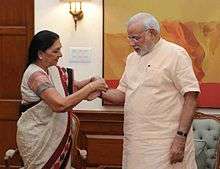
In Maharashtra, the festival of Raksha Bandhan is celebrated as Narali Poornima. Kolis are the fishermen community of the coastal state. These Kolis offered prayers to Lord Varuna to invoke his blessings. As part of the rakhi rituals, coconuts were thrown into the sea as offerings to Lord Varuna. The Kolis also applied vermillion on each other's foreheads as a symbol of prosperity and joy.
Jammu (Kashmir)
In the regions of North India, mostly Jammu, it is a common practice to fly kites on the nearby occasions of Janamashtami and Raksha Bandhan. It's not unusual to see the sky filled with kites of all shapes and sizes, on and around these two dates. The kites start appearing in the sky around one month before the actual date of the festival. As the date grows closer, the number of kites in the sky increases proportionally.
The locals buy kilometres of strong kite string, commonly called as "gattu door" in the local language, along with a multitude of kites. They are willing to spend more than a couple of thousands to buy the things that they need for this kite flying extravaganza.[64]
Haryana and Punjab
In Haryana and Punjab, in addition to celebrating Raksha Bandhan, people observe the festival of Salono.[65] Salono is celebrated by priests solemnly tying amulets against evil on people's wrists.[66][67] The day is dedicated to local saints involving devotees receiving such amulets.[68] In Haryana, the festival of Salono also involves sisters tying threads on brothers to ward off evil.[69] Despite the two festivals being similar in its practices, Salono and Raksha Bandhan are distinct observances with the threads tied for Salono being called ponchis.[70][71]
Uttar Pradesh
The sister ties rakhi on the wrist of her brother, who promises to protect her always.
See also
 India portal
India portal Hinduism portal
Hinduism portal- Bhau-beej
- Other festivals observed on the day of Raksha Bandhan
- Siblings Day
- Friendship bracelet
References
- ↑ Verma, Priyanka (27 March 2014). "Rakshabandhan: Festival of India". Diamond Pocket Books Pvt Ltd. Retrieved 19 August 2016 – via Google Books.
- ↑ K. Moti Gokulsing, Wimal Dissanayake (4 February 2009), Popular culture in a globalised India, Taylor & Francis, 2009, ISBN 978-0-415-47667-6, retrieved 16 August 2011,
... Raksha Bandhan: A popular festival of Indian Sub-continent where sister ties a thread on brother's wrist, signifying love and/or seeking protection ...
- ↑ "Meaning of Raksha Bandhan, Significance of Rakhi, Rakshabandhan Significance, Meaning of Rakhi". Retrieved 19 August 2016.
- ↑ Sylvie Langlaude (2007), The right of the child to religious freedom in international law, Martinus Nijhoff Publishers, 2007, ISBN 978-90-04-16266-2, retrieved 16 August 2011,
...
- ↑ Singh, Kumar Suresh; India, Anthropological Survey of (1 January 2004). "People of India". Anthropological Survey of India. Retrieved 19 August 2016 – via Google Books.
- 1 2 3 4 5 6 7 J Gordon Melton (Editor), Religious Celebrations: An Encyclopedia of Holidays Festivals Solemn Observances and Spiritual Commemorations, ISBN 978-1598842067; pp 733–734
- 1 2 3 "Raksha Bandhan Being Celebrated Across India". HINDUISM TODAY. 24 August 2013. Retrieved 17 August 2016.
- ↑ Peggy Holroyde, Muhammad Iqbal, Dharam Kumar Vohra (1973) East Comes West: A Background to Some Asian Faiths
- ↑ Gupta, Hari Ram (1978) History of the Sikhs: The Sikh lion of Lahore, Maharaja Ranjit Singh, 1799–1839
- ↑ General, India Office of the Registrar. "Census of India, 1961: Punjab". Manager of Publications. Retrieved 19 August 2016 – via Google Books.
- ↑ Raksha Bandhan, BBC, 28 August 2009, retrieved 16 August 2011,
... when a woman ties a rakhi around the hand of a man it becomes obligatory for him to honour his religious duty and protect her ...
- ↑ Dale Hoiberg, Indu Ramchandani, Students' Britannica India, Popular Prakashan, 2000, ISBN 978-0-85229-760-5, retrieved 16 August 2011,
... Raksha Bandhan (also called Rakhi), when girls and women tie a rakhi (a symbolic thread) on their brothers' wrists and pray for their prosperity, happiness and goodwill. The brothers, in turn, give their sisters a token gift and promise protection ...
- 1 2 3 S. Sehgal (1999), Encyclopaedia of Hinduism, Vol 3, ISBN 978-8176250641, pp. 536–537
- ↑ "Rakhi festival celebrated in Taxila". Dawn. Com. 12 August 2011. Retrieved 27 July 2012.
- ↑ Guyanese in London, NY observed Raksha Bandhan Guyana Chronicle (August 2013)
- 1 2 3 4 Sue Penney (2007), Hinduism, Heinemann Library, ISBN 978-1432903145, page 33
- ↑ Gnanambal, K. (2008), Festivals on an All India Basis, Festivals In Indian Society, pp 65
- ↑ Christine Moorcroft (31 March 1995), Folens religious education, Folens Limited, 1995, ISBN 978-1-85276-397-8, retrieved 16 August 2011,
... sisters tie to their brothers' or male cousins' wrists ...
- ↑ Edward Balfour (1885), The cyclopaedia of India and of eastern and southern Asia, Volume 2, B. Quaritch, 1885, retrieved 16 August 2011,
... Muh-Bola-Bhai. Hind. An adopted brother ... Brother-making; Rakhi ...
- ↑ Arora, P. (1986), Hindu festivals of India, The, Journal of Popular Culture, 20(2), pp 175–182
- ↑ Bobbie Kalman, India – The Culture, Crabtree Publications, ISBN 978-0778792871, page 21
- 1 2 3 Manish Verma (2010), Fasts & Festivals Of India, Diamond Books, ISBN 978-8171820764; pp 40–41
- ↑ Satvinder Kaur, Sarojini Naidu's poetry, Sarup & Sons, ISBN 81-7625-428-2, pp 302–305
- ↑ Horace Hayman Wilson (1868), The Vishńu Puráńa: a system of Hindu mythology and tradition, Volume 4, Editor: Fitzedward Hall, Trubner & Co., London, pp 276–278
- ↑ Vishnu Purana – Book 5, Chapter 5, Verses 14–23
- ↑ Desiree Webber et al., Travel the Globe: Story Times, Activities, and Crafts for Children, Libraries Unlimited, ISBN 978-1610691246, pp 132–133
- ↑ Roger Whiting, Religions for Today, ISBN 978-0748705863, Dufour, page 182
- 1 2 The Legends of Rakhi The Society for the Confluence of Festivals in India (2012)
- ↑ Prem Bhalla, Hindu Rites, Rituals, Customs and Traditions: A to Z on the Hindu Way of Life, Pustak Mahal, ISBN 978-8122309027
- ↑ Robert L. Brown (1991), Ganesh: studies of an Asian god, SUNY Press, 1991, ISBN 978-0-7914-0656-4, retrieved 16 August 2011,
...The boys are jealous, as they, unlike their father, have no sister with whom to tie the rakhi. They and the other women plead with their father, but to no avail; but then Narada appears and convinces Ganehsa that the creation of an illustrious daughter ... a flame that engenders Santoshi Maa...
- ↑ Mark Fox and Olga Fox, Time to Celebrate: Identity, Diversity and Belief, ISBN 978-1-86366-703-6, Curriculum Corporation
- ↑ Roshen Dalal (2011), Hinduism: An Alphabetical Guide, Penguin, ISBN 978-0143414216, page 64
- ↑ Tharoor, Shashi (1 January 2007). The Elephant, the Tiger, and the Cell Phone: Reflections on India, the Emerging 21st-century Power. Penguin Books India. p. 148. ISBN 9780670081455.
- ↑ "BBC – Religions – Hinduism: Raksha Bandhan (Rakhi)". Retrieved 17 August 2016.
- ↑ BSF soldiers celebrated Rakhi at border in Jammu, India (2012) Archived 25 July 2014 at the Wayback Machine.
- ↑ Fulton, Helene (2015). Beware of False Religions & Pagan Traditions Part 2. Lulu.com. p. 111. ISBN 9780620608909.
- 1 2 "Rakhi: Symbol of secularism". The Economic Times.
Raksha Bandhan is a secular festival, say liberal Muslims who have no qualms about celebrating it within and outside the community.
- ↑ Rahemtulla, Nazlin; Fairweather, Margaret (1 June 2012). Rsvp Rice and Stew Very Plenty. FriesenPress. p. 75. ISBN 9781770972674.
- ↑ Jawed, Mohammad Aslam (1 January 1996). "The unknown Iqbal". Kitab Pub. House. Retrieved 19 August 2016 – via Google Books.
- ↑ Sahay, K.N. (1986). Christianity And Culture Change In India. Inter-India Publications. ISBN 9788121001731. Retrieved 29 September 2016.
- ↑ McLeod, W. H. (1 January 1997). "Sikhism". Penguin Books. Retrieved 19 August 2016 – via Google Books.
- ↑ Nesbitt, Eleanor (22 September 2005). "Sikhism: A Very Short Introduction". OUP Oxford. Retrieved 19 August 2016 – via Google Books.
- ↑ "The Sikh Review". Sikh Cultural Centre. 1 January 2001. Retrieved 19 August 2016 – via Google Books.
- ↑ Singh, Nikky-Guninder Kaur (15 March 2011). Sikhism: An Introduction. I.B.Tauris. p. 94. ISBN 9781848853218.
- ↑ Varma, Pavan K. (2008). Ghalib. Penguin Books India. p. 50. ISBN 9780143064817.
- ↑ Misbah Nayeem Quadri (5 August 2009), "Rakhi strengthens communal ties", DNA India, ISBN 978-0-85229-760-5, retrieved 16 August 2011,
... But even today, in many cities across the country, Hindu girls tie rakhi on the wrist of youths they consider their brothers.
- ↑ India cultures quarterly, Volume 25, School of Research, Leonard Theological College, 1968, 1 January 1968, retrieved 16 August 2011,
... They themselves took her to Porus and there she performed the ceremony of raksha bandhan ...
- ↑ "History And Significance Of Raksha Bandhan". Raksha Bandhan. 7 July 2014. Retrieved 17 August 2016.
- ↑ Satish Chandra (2005), Medieval India: from Sultanat to the Mughals, Volume 2, Har-Anand Publications, 2005, ISBN 978-81-241-1066-9, retrieved 16 August 2011,
... According to a mid-seventeenth century Rajasthani account, Rani Karnavati, the Rana's mother, sent a bracelet as rakhi to Humayun, who gallantly responded and helped. Since none of the contemporary sources mention this, little credit can be given to this story ...
- ↑ Gaurav Pradhan, Rabindranath Tagore: Literary Concepts, APH Publishing, ISBN 978-8176482790, page 33
- ↑ K. S. Bharathi, Encyclopedia of Eminent Thinkers, see Tagore, ISBN 81-7022-684-8, page 14
- ↑ AP Sharma, Famous Festivals of India, ISBN 978-81-87057-50-5, see Raksha Bandhan
- ↑ Rabindranath Tagore, The Jewel that is Best: Collected Brief Poems, Penguin, ISBN 978-0-143415-633, page 118
- ↑ Patwant Singh, Jyoti M. Rai (2013) Empire of The Sikhs: Revised Edition
- ↑ Hari Ram Gupta (1978) History of the Sikhs: The Sikh lion of Lahore, Maharaja Ranjit Singh, 1799–1839
- ↑ Indian Information. Bureau of the public information of the government of India. 1948. p. 22.
- ↑ Lal, Prem Hari Har (1993). The Doon Valley Down the Ages. Interprint. p. 276. ISBN 9788185017648.
- ↑ TNN (30 August 2015). "On Rakhi, a unique gender twist" (Kolkata). The Times of India. Retrieved 7 September 2015.
- ↑ "Janopunya Festival Uttarakhand Janopunya Festival Tour Uttarakhand Tourism Uttarakhand Fairs and Festivals Uttarakhand Tour Packages". Archive.is. 5 February 2013. Archived from the original on 5 February 2013. Retrieved 25 August 2013.
- ↑ Indo Vacations Team. "Uttaranchal, Information about Uttaranchal Festival, Uttaranchal Festivals". Indovacations.net. Retrieved 25 August 2013.
- ↑ "Jhulan Purnima | Puri Waves". Puriwaves.nirmalya.in. 10 August 1934. Retrieved 25 August 2013.
- ↑ "Janai Purnima today – Detail News : Nepal News Portal". The Himalayan Times. Retrieved 25 August 2013.
- ↑ "Janai Purnima, nepal culture, nepal family festivals, nepal religionnepal tourism festivals". colorfulnepal.com. Archived from the original on 30 May 2012. Retrieved 25 August 2013.
- ↑ http://www.greaterkashmir.com/news/jammu/festivities-kite-flying-mark-rakshabandhan-celebrations/101468.html http://www.earlytimes.in/newsdet.aspx?q=129428
- ↑ Kumar Suresh Singh, Madan Lal Sharma, A. K. Bhatia, Anthropological Survey of India (1994)
- ↑ "Haryana District Gazetteers: Rohtak district gazetteer, 1910". Gazetteers Organisation, Revenue Department, Haryana. 1 January 2000. Retrieved 19 August 2016 – via Google Books.
- ↑ General, India Office of the Registrar (1 January 1965). "Census of India, 1961". Manager of Publications. Retrieved 19 August 2016 – via Google Books.
- ↑ "Karnal District Gazetteer" (PDF). Retrieved 17 August 2016.
- ↑ Gupta, Shakti M. (1 January 1991). "Festivals, Fairs, and Fasts of India". Clarion Books. Retrieved 19 August 2016 – via Google Books.
- ↑ Beckerlegge, Gwilym (1 January 2001). "World Religions Reader". Psychology Press. Retrieved 19 August 2016 – via Google Books.
- ↑ Lewis, Oscar (1865) Village Life in Northern India: Studies in a Delhi Village
External links
| Wikimedia Commons has media related to Raksha Bandhan. |
- Raksha Bandhan Know India – Festivals, Government of India
- Raksha Bandhan Government of Odisha, India

